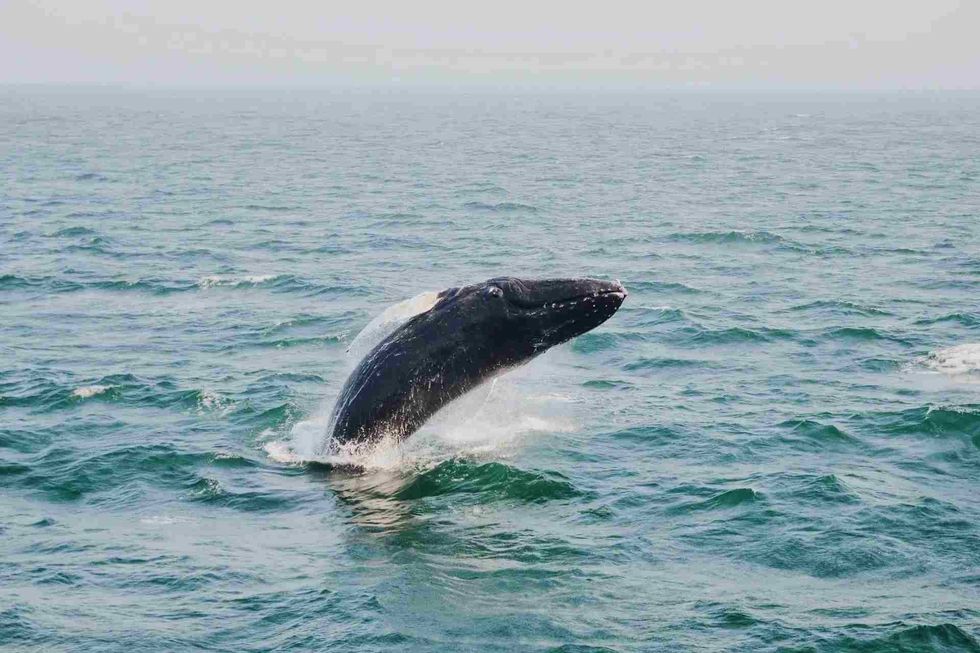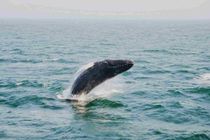Omura's whale, also known as dwarf fin whale is a smaller species of rorqual, which also includes humpbacks and blue whales, and very little is known about it.
The species was discovered in 2003 as a dead specimen, but observed live in 2015. Scientists mistook it for pygmy Bryde's whale when the Japanese whaler caught them in the 1970s in Western Pacific ocean and Eastern Indian.
But later, after examining the DNA of these fish species, they determined that the whale represents a species, which is completely new to science.
It wasn't until 12 years later that scientists observed this fish species in the wild mostly between 2011 to 2014, and their presence came to be known, which was once believed to be a mythical ghost whale.
This fish may be characterized by small local population, and to date the total number of these fish present in the world is unknown, and scientists are still in the path of unraveling more information about the omura's whale.
It is one of the smaller and more streamlined baleen whales.
It is the most recently identified whale species. They partake in lunge feeding.
If you want to know more about the aquatic species, you should also check out tayra facts and puma facts too.
Omura's Whale Interesting Facts
What type of animal is an Omura's whale?
Omura's whales are a type of whale fish species.
What class of animal does an Omura's whale belong to?
Omura's whale Balaenoptera omurai belongs to the Mammalia class of animal, since they are marine mammals.
How many Omura's whales are there in the world?
The total number of Omura's whale population is unidentified since the species was discovered only in recent years.
Where does an Omura's whale live?
Omura's whales generally live in tropical and warm temperate oceans, in tropical waters, deep in the waters. They are found in the Atlantic and Indo-Pacific oceans.
Although they are seldom observed, Omura's whales are still being discovered and seen in new places, and it is believed that in the coming years, their sighting and discoveries might demonstrate that these baleen whales live in tropical and warm, temperate waters across the world. They have also been spotted in northwestern Madagascar all year round.
What is an Omura whale's habitat?
The Omurai habitat can be found in tropical or subtropical regions, primarily in deep coastal waters. They have been spotted swimming through the waters of Southern and Western Australia, Malaysia, Philippines, China, Thailand, Indian oceans, as well as other regions.
They are also believed to be a nonmigratory fish species. Omura's whales or Bryde's whales appear to be distributed exclusively on shallow continental shelf habitats and deep waters.
Who does Omura's whale live with?
The information on whom Bryde's whales live with, whether in groups or pairs or alone, is still unidentified. But scientists believe that many of the baleen whale species, such as Bryde's whale, might live alone or in small groups of up to three or four, as they are often spotted alone or in two to four groups.
How long does an Omura's whale live?
Not much information has been discovered regarding the total lifespan of this whale species. Climate change, ship strikes, and fishing gear used by humans for fishing are major threats to their lives.
How do they reproduce?
Omura's whales or Bryde's whales reproduce via sexual meiosis, where the male and female produce haploid gametes. Male gametes are sperms, while the female whale gametes are eggs, and a single egg and sperm fertilize to form a diploid zygote.
However, their reproduction hasn't been observed by scientists as yet.
But, of the three females caught in the Solomon sea, two were ovulating and lactating, whereas one was just resting and not ovulating or lactating. This whale species is known to have one or two calves and they are marine mammals that feed on their mother.
What is their conservation status?
According to the IUCN red list, the Omura's whale conservation status is Data Deficient since they are newly discovered whale species, and their population is still under the study of experts.
Omura's Whale Fun Facts
What does Omura's whale look like?
Omura's whales or baleen whales are thin, long and super streamlined marine mammals which gives them a distinctive snake-like appearance.
The whale Omura's body is asymmetrically marked, like that of a fin whale, and they have counter-shaded, dark grayish color above and a whitish belly. When they are in the water, due to the ocean light, they appear light bluish.
As they belong to the rorqual family of baleen whales, they have throat pleats.
Their lower jaw on the right side is white and dark on the left, with four black stripes on the right head, and they have asymmetrical chevrons on their backs.
On the front of the head, Omura's whales have a single defined ridge, with small, strongly hooked or curved dorsal fin, flippers with white leading edges, along with a very straight trailing edge and broad tail.
They are also known to resemble the blue whale in many ways since they belong to the same fish species.

How cute are they?
Even though they are great in size, these harmless marine mammals have a cute feature, that is, being harmless to humans.
How do they communicate?
Their means of communication is unclear, but this fin whale sings a low and repetitive melody that they usually repeat for an hour or so. Occasionally, in an Omura's whale chorus, multiple whales raise their voices.
Researchers believe that this behavior of the Omura's whales is males gathering the females and fighting it out, or perhaps wooing her with ballads.
How big is Omura's whale
Omura's whales are 15 times bigger than killer whales.
How fast can an Omura's whale swim?
The swimming speed of the Bryde's whales (Balaenoptera edeni) is unknown, but if they have the same speed as the blue whale, they may be able to swim 31.1 mph.
How much does an Omura's whale weigh?
Omura's whales can weigh up to 70,540 oz (20,000 kg).
What are their male and female names of the species?
The male and female species are simply known as Omura's whales.
What would you call a baby Omura's whale?
A baby Omura's whale is generally known as calf.
What do they eat?
This whale species have throat pleats and are known to lunge feeding, where they feed predominantly on schooling fish and krill filtered from the seawater. Their preference for tropical sea habitat does not provide them with abundant food, and they don't even seem to migrate to colder waters where food is abundant.
Are they poisonous?
Little is known about this fish species, and not much information has been accumulated regarding whether they are poisonous in nature or not.
Would they make a good pet?
They are wild whales who grow up with their mother as marine mammals and raising them as a pet can be difficult for both you and the whale. They are mostly left in the wild and not raised as pets since they are big in size and can grow up to 70,540 ounces (20,000 kg) and even more.
Did you know...
This whale has a dorsal fin that is bow-shaped and rises sharply in a vertical manner.
Omura's whales have a total of 21 caudal, 53 vertebrae, 12 lumbar, 13 thoracics, including seven cervical, which is the standard number among mammals.
These whales are one of the smallest, along with the baleen whale species.
In Boston, Massachusetts, Salvatore Cerchio of New England Aquarium led a team and published a paper that includes a map of all known sightings of the Omura's whales, which demonstrates that the whale has a much larger distribution range than previously thought.
What do fin whales look like?
A fin whale generally has a sleek, streamlined body, along with a V-shaped head, with a tall, hooked dorsal fin, and about two-thirds of its back rises at a shallow angle from the back.
These whales have distinctive coloration, with dark browning gray or black back and sides and white underside, and they do not have scales but a smooth skin texture.
What are a bowhead and Omura?
Bowhead whales and Omura's whales are both species of baleen whales. They have similarities but even more differences.
The bowhead whales are entirely black with a white lower jaw, while Omura's whales have asymmetric black and white color on their head and jaw. However, the bowhead is 20 times bigger than the Omura's whales, whose weight can reach up to 54,500 kg.
Here at Kidadl, we have carefully created lots of interesting family-friendly animal facts for everyone to discover! Learn more about some other mammals including blue wildebeest facts and African wildcat facts.
You can even occupy yourself at home by drawing one on our Whale coloring pages.










